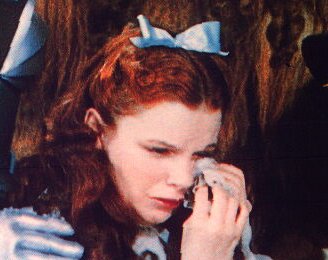America invades Oz: close analysis of the Wizard
The Wizard of Oz himself is a conman who just happened to arrive in a new land surrounded by good circumstance. He rose to power because of the people’s desires to believe in someone, and not because of his own skill set. Oz is clearly commentary on government and how capitalism and greed transforms governing powers, but I wanted to shift this commentary from the Emerald City as a whole and focus solely on the mastermind behind the transformation in Oz.
 In the popular 1939 film adaptation of the Wizard of Oz, the conman predicting Dorothy’s future in the beginning of the film is the same man who plays the Wizard at the end of the film. I did not see this parallel until I was older, but once I noticed I also saw the parallels between their actions. Despite the characters’ means of achieving his goals, he typically had good intentions. The conman at the beginning of the film wanted to get Dorothy to go home and tricked her into doing so. The Wizard wanted Dorothy, the scarecrow, the tin man, and the lion to emulate the qualities they desired instead of being handed them. He also wanted Oz to flourish, and did so in the only way he knew how: introduce the people to money. These actions remind me of government protection. The whole “we are doing this for your own good” mantra that gives purpose to the idea of Big Brother in this country.
In the popular 1939 film adaptation of the Wizard of Oz, the conman predicting Dorothy’s future in the beginning of the film is the same man who plays the Wizard at the end of the film. I did not see this parallel until I was older, but once I noticed I also saw the parallels between their actions. Despite the characters’ means of achieving his goals, he typically had good intentions. The conman at the beginning of the film wanted to get Dorothy to go home and tricked her into doing so. The Wizard wanted Dorothy, the scarecrow, the tin man, and the lion to emulate the qualities they desired instead of being handed them. He also wanted Oz to flourish, and did so in the only way he knew how: introduce the people to money. These actions remind me of government protection. The whole “we are doing this for your own good” mantra that gives purpose to the idea of Big Brother in this country.
 Wicked is a popular Broadway musical that tells the story of the witches of Oz. The story follows Glinda, a good witch, and Elphaba, who eventually becomes the Wicked Witch of the West. In this version of the tale, the Wizard is responsible for stripping animals of their rights, but the biggest twist not seen in the original tale is that he plans to use Elphaba’s power to keep up his allusion of wizardry to the people. This technique, again, ties to the Big Brother idea of government in the U.S. Who and what exactly is controlling us? One of the problems with our government is the limited amount of transparency. The play Wicked as well as the other adaptations of Oz criticize the need for transparency in government to not only create a sense of mutual trust between citizens and those in power, but also to avoid abuse of power.
Wicked is a popular Broadway musical that tells the story of the witches of Oz. The story follows Glinda, a good witch, and Elphaba, who eventually becomes the Wicked Witch of the West. In this version of the tale, the Wizard is responsible for stripping animals of their rights, but the biggest twist not seen in the original tale is that he plans to use Elphaba’s power to keep up his allusion of wizardry to the people. This technique, again, ties to the Big Brother idea of government in the U.S. Who and what exactly is controlling us? One of the problems with our government is the limited amount of transparency. The play Wicked as well as the other adaptations of Oz criticize the need for transparency in government to not only create a sense of mutual trust between citizens and those in power, but also to avoid abuse of power.











